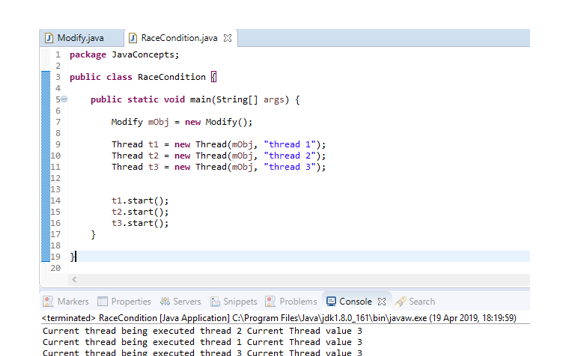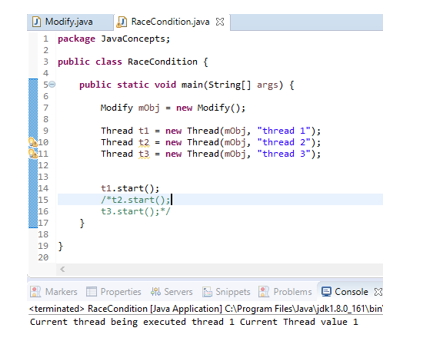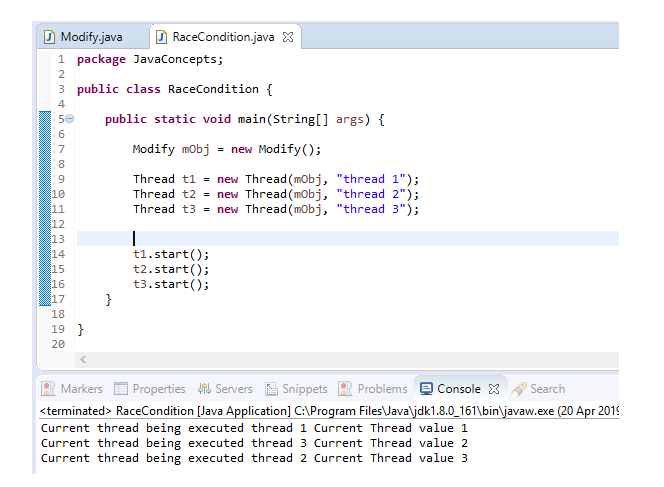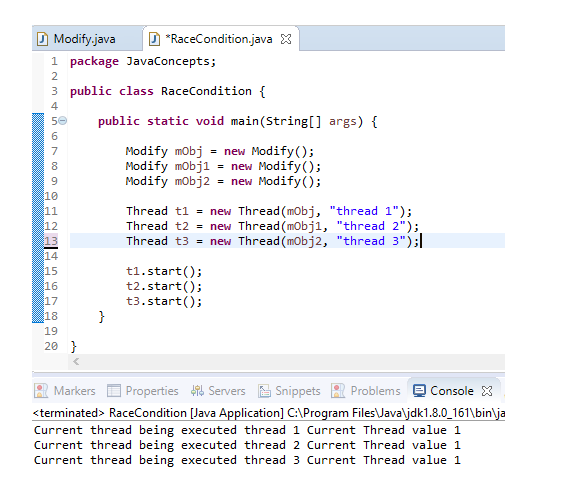Updated May 8, 2023
Introduction to Synchronization in Java
Synchronization in Java is a Java feature that restricts multiple threads from trying to access the commonly shared resources at the same time. Here shared resources refer to external file contents, class variables, or database records.
Synchronization is widely used in multithreaded programming. “Synchronized” is the keyword that provides your code with the ability to allow only a single thread to operate on it without interference from any other thread during that period.
Why do we need Synchronization in Java?
- Java is a multithreaded programming language. This means two or more threads can run simultaneously towards the completion of a task. When threads run simultaneously, there are high chances of a scenario to occur where your code might provide unexpected outcomes.
- You might wonder that if multithreading can cause erroneous outputs, then why is it considered an important feature in Java?
- Multithreading makes your code faster by running multiple threads in parallel, reducing your codes execution time and providing high performance. However, making use of the multithreading environment leads to inaccurate outputs due to a condition commonly known as a race condition.
What is a Race Condition?
When two or more threads run in parallel, they tend to access and modify shared resources at that point in time. The thread scheduling algorithm decides the sequences in which the threads get executed.
Due to this, one cannot predict the order in which threads will be executed as the thread scheduler controls it solely. This affects the output of the code and results in inconsistent outputs. Since multiple threads are racing with each other to complete the operation, the condition is referred to as “racing condition”.
For Example, let us consider the below code:
class Modify:
package JavaConcepts;
public class Modify implements Runnable{
private int myVar=0;
public int getMyVar() {
return myVar;
}
public void setMyVar(int myVar) {
this.myVar = myVar;
}
public void increment() {
myVar++;
}
@Override
public void run() {
// TODO Auto-generated method stub
this.increment();
System.out.println("Current thread being executed "+ Thread.currentThread().getName() + "Current Thread value " + this.getMyVar());
}
}
class RaceCondition:
package JavaConcepts;
public class RaceCondition {
public static void main(String[] args) {
Modify mObj = new Modify();
Thread t1 = new Thread(mObj, "thread 1");
Thread t2 = new Thread(mObj, "thread 2");
Thread t3 = new Thread(mObj, "thread 3");
t1.start();
t2.start();
t3.start();
}
}On consecutively running the above code, the outputs will be as follows:
Ourput1:
The current thread being executed thread 1 Current Thread value 3
The current thread being executed thread 3 Current Thread value 2
The current thread being executed thread 2 Current Thread value 3
Output2:
The current thread being executed thread 3 Current Thread value 3
The current thread being executed thread 2 Current Thread value 3
The current thread being executed thread 1 Current Thread value 3
Output3:
The current thread being executed thread 2 Current Thread value 3
The current thread being executed thread 1 Current Thread value 3
The current thread being executed thread 3 Current Thread value 3
Output4:
The current thread being executed thread 1 Current Thread value 2
The current thread being executed thread 3 Current Thread value 3
The current thread being executed thread 2 Current Thread value 2
- From the above example, you can conclude that the threads are being executed at random and also, the value is incorrect. As per our logic, the value should be incremented by 1. However, here the output value in most cases is 3, and in a few cases, it’s 2.
- Here the “myVar” variable is the shared resource on which multiple threads are executing. The threads are accessing and modifying the value of “myVar” simultaneously. Let us see what happens if we comment out the other two threads.
The output in this case is:
The current thread being executed thread 1 Current Thread value 1
This means when a single thread is running, the output is as expected. However, when multiple threads are running, the value is being modified by each thread. Therefore, one needs to restrict the number of threads working on a shared resource to a single thread at a time. This is achieved using synchronization.
Understanding What is Synchronization in Java
- Synchronization in Java is achieved with the help of the keyword “synchronized”. This keyword can be used for methods or blocks, or objects but cannot be used with classes and variables. A synchronized piece of code allows only one thread to access and modify it at a given time.
- However, a synchronized piece of code affects code performance as it increases the waiting time of other threads trying to access it. So a piece of code should be synchronized only when there is a chance for a race condition to occur. If not, one should avoid it.
How does Synchronization in Java work internally?
- Internally synchronization in Java has been implemented with the help of the lock (also known as a monitor) concept. Every Java object has its own lock. In a synchronized block of code, a thread needs to acquire the lock before being able to execute that particular block of code. Once a thread acquires the lock, it can execute that piece of code.
- On completion of execution, it automatically releases the lock. If another thread requires to operate on the synchronized code, it waits for the current thread operating on it to release the lock. This process of acquiring and releasing locks is internally taken care of by the Java virtual machine. A program is not responsible for acquiring and release of locks by the thread. The remaining threads can, however, execute any other non-synchronized piece of code simultaneously.
Let us synchronize our previous example by synchronizing the code inside the run method using the synchronized block in class “Modify” as below:
class Modify:
package JavaConcepts;
public class Modify implements Runnable{
private int myVar=0;
public int getMyVar() {
return myVar;
}
public void setMyVar(int myVar) {
this.myVar = myVar;
}
public void increment() {
myVar++;
}
@Override
public void run() {
// TODO Auto-generated method stub
synchronized(this) {
this.increment();
System.out.println("Current thread being executed "
+ Thread.currentThread().getName() + " Current Thread value " + this.getMyVar());
}
}
}The code for the class “RaceCondition” remains the same. Now on running the code, the output is as follows:
Output1:
The current thread being executed thread 1 Current Thread value 1
The current thread being executed thread 2 Current Thread value 2
The current thread being executed thread 3 Current Thread value 3
Output2:
The current thread being executed thread 1 Current Thread value 1
The current thread being executed thread 3 Current Thread value 2
The current thread being executed thread 2 Current Thread value 3
Notice that our code is providing the expected output. Here every thread is incrementing the value by 1 for the variable “myVar” (in class “Modify”).
For Example, let us modify the code in the class “RaceCondition” as below and work with the previously unsynchronized class “Modify”.
package JavaConcepts;
public class RaceCondition {
public static void main(String[] args) {
Modify mObj = new Modify();
Modify mObj1 = new Modify();
Modify mObj2 = new Modify();
Thread t1 = new Thread(mObj, "thread 1");
Thread t2 = new Thread(mObj1, "thread 2");
Thread t3 = new Thread(mObj2, "thread 3");
t1.start();
t2.start();
t3.start();
}
}Output:
The current thread being executed thread 1 Current Thread value 1
The current thread being executed thread 2 Current Thread value 1
The current thread being executed thread 3 Current Thread value 1
Types of Synchronization in Java
There are two types of thread synchronization, one being mutually exclusive and the other inter-thread communication.
1. Mutually Exclusive
- In this case, threads obtain the lock before operating on an object, thereby avoiding working with objects that have had their values manipulated by other threads.
- This can be achieved in three ways:
i. Synchronized Method
We can make use of the “synchronized” keyword for a method, thus making it a synchronized method. Every thread that invokes the synchronized method will obtain the lock for that object and release it once its operation is completed. In the above example, we can make our “run()” method as synchronized by using the “synchronized” keyword after the access modifier.
@Override
public synchronized void run() {
// TODO Auto-generated method stub
this.increment();
System.out.println("Current thread being executed "
+ Thread.currentThread().getName() + " Current Thread value " + this.getMyVar());
}
The output for this case will be:
The current thread being executed thread 1 Current Thread value 1
The current thread being executed thread 3 Current Thread value 2
The current thread being executed thread 2 Current Thread value 3
ii. Static synchronized method
In order to synchronize static methods, one needs to acquire its class level lock. After a thread obtains the class level lock, only then it will be able to execute a static method. While a thread holds the class level lock, no other thread can execute any other static synchronized method of that class. However, the other threads can execute any other regular method or regular static method or even non-static synchronized method of that class.
For example, let us consider our “Modify” class and make changes to it by converting our “increment” method to a static synchronized method. The code changes are as below:
package JavaConcepts;
public class Modify implements Runnable{
private static int myVar=0;
public int getMyVar() {
return myVar;
}
public void setMyVar(int myVar) {
this.myVar = myVar;
}
public static synchronized void increment() {
myVar++;
System.out.println("Current thread being executed " + Thread.currentThread().getName() + " Current Thread value " + myVar);
}
@Override
public void run() {
// TODO Auto-generated method stub
increment();
}
}iii. Synchronized block
One of the main disadvantages of the synchronized method is that it increases threads waiting time, impacting the performance of the code. Therefore, to synchronize only the required lines of code in place of the entire method, one needs to make use of a synchronized block. Using synchronized block reduces the waiting time of the threads and improves performance as well. In the previous example, we have already made use of synchronized block while synchronizing our code for the first time.
Example:
public void run() {
// TODO Auto-generated method stub
synchronized(this) {
this.increment();
System.out.println("Current thread being executed "
+ Thread.currentThread().getName() + " Current Thread value " + this.getMyVar());
}
}2. Thread Co-ordination
For synchronized threads, inter-thread communication is an important task. Inbuilt methods that help achieve inter-thread communication for synchronized code are namely:
- wait()
- notify()
- notifyAll()
i. wait()
A thread on invoking the wait() method releases the lock on the object and goes into a waiting state. It has two method overloads:
- public final void wait()throws InterruptedException
- public final void wait(long timeout)throws InterruptedException
- public final void wait(long timeout, int Nanos) throws InterruptedException
ii. notify()
A thread sends a signal to another thread in the waiting state by making use of the notify() method. It sends the notification to only one thread such that this thread can resume its execution. Which thread will receive the notification among all the threads in the waiting state depends on the Java Virtual Machine.
public final void notify()iii. notifyAll()
When a thread invokes the notifyAll() method, every thread in its waiting state is notified. These threads will be executed one after the other based on the order decided by the Java Virtual Machine.
public final void notifyAll()Conclusion
In this article, we have seen how working in a multi-threaded environment can lead to data inconsistency due to a race condition, how synchronization helps us overcome this by limiting a single thread to operate on a shared resource at a time. Also, how synchronized threads communicate with each other.
Recommended Articles
This has been a guide to What is Synchronization in Java?. Here we discuss the introduction, understanding, need, working and types of synchronization with some sample code. You can also go through our other suggested articles to learn more –






